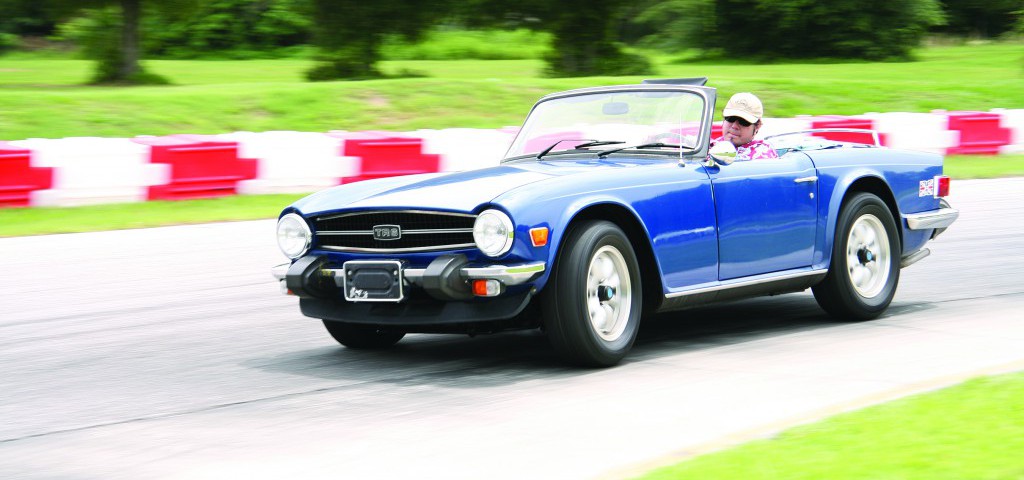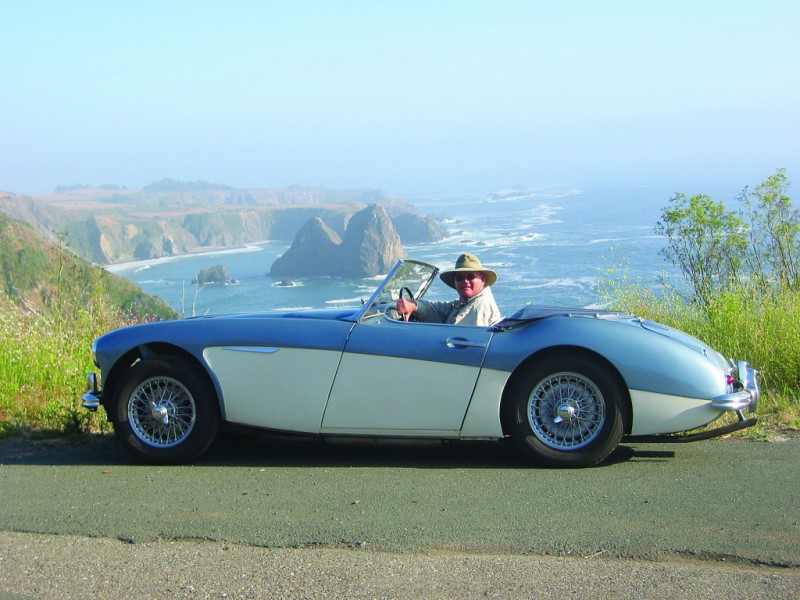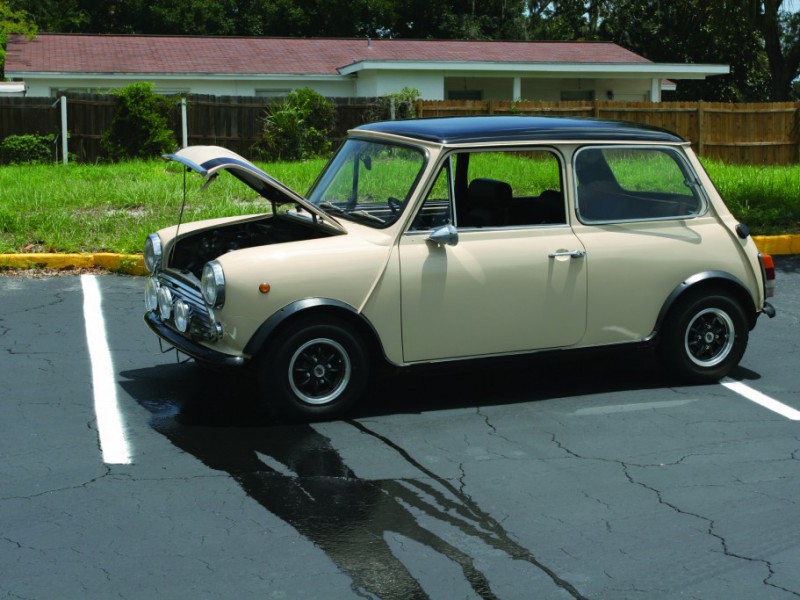
Whether on the road or track, you want your classic to handle well. Reviving an old suspension while also raising the limits a few ticks can be easily accomplished.
Despite their swoopy sheet metal and well-earned racing pedigree, a lot of our British classics aren’t super-advanced when it comes to suspension. There’s precious little suspension adjustment available up front, while the live axle often used in the back is about as basic as they come.
Add in a few decades of use and component degradation, and our cars are now wallowing to keep up with traffic. It’s a sad day when an MGB can’t out-handle a minivan that’s on its way to soccer practice.
All is not lost, though, as a few simple modifications can greatly improve your British classic’s handling. The parts needed for this upgrade are far from exotic, and the work can usually be done with simple hand tools. Best of all, the project can yield performance that would equal the factory-supported racers of yesteryear.
 Step 1: Tires and Wheels
Step 1: Tires and Wheels
Just about everything that a driver asks a car to do—steer, stop and accelerate—is directed through the four tires, each one with a contact patch not much bigger than the palm of your hand. Tire health is critical to handling and is where any suspension work should begin.
First, a tire that is either over- or under-inflated will not properly grip the road. And you can’t check a tire’s pressure by eyeballing it. A trusted tire pressure gauge is required, and don’t forget that tires naturally lose pressure over time, especially during drops in ambient temperature. (Moss just happens to stock an all-brass, highly accurate gauge, by the way.)
Another factor is tire age. Despite the amount of tread showing, most tires only have a life span of about six years. After that, the rubber and other compounds break down to the point that handling and safety will be compromised. The tires may seem to drive just fine, but they will mostly likely come up short when asked to tackle any kind of emergency maneuver.
Even though Moss does not supply tires, the company can still help maximize grip: a set of wider wheels will improve a car’s footprint and can also help owners fit today’s modern radials on yesterday’s classics. The sad truth is that sporty tires no longer come sized for 4- and 5-inch-wide wheels. In many cases, going to a slightly wider wheel—whether it’s a Panasport, Minilite reproduction or other option—will open the door for alternatives.
 Step 2: Removing the Slop
Step 2: Removing the Slop
When we turn next to the parts, there’s an important fact to remember: Most of these cars are 30, 40 and in some cases more than 50 years old. How can a car be expected to handle well when the suspension is hopping and fluttering all over the place?
The first goal is to at least get the cars back to stock configuration by replacing any old, worn-out parts. Rubber suspension bushings deteriorate over time, allowing unwanted suspension movement and, in extreme cases, letting metal components come in contact with one another.
Fortunately, replacement bushings are still in production, and in many cases the price is quite reasonable. A complete MGB major front suspension kit is $169.95, while the individual bushings for the TR6’s upper wishbones cost 85 cents each.
Stock rubber bushings have served enthusiasts for decades, but now there is a popular alternative: polyurethane. The stiffer polyurethane bushings offer a bit tighter handling and longer life.
 Step 3: Shocking
Step 3: Shocking
Let’s tackle some semantics first: The term shock absorber is actually a misnomer, as these suspension components don’t exactly absorb shocks. Think of them as dampers and you’ll be heading in the right direction. The springs support the car, and the shock absorbers actually damp the springs by timing how quickly they extend and compress.
A shock absorber is in rebound when its piston is pulled out from the body; the unit is in compression when that same piston is pushed into the shock absorber’s body. How quickly this compression and rebound occur greatly impacts a car’s handling.
Another fact of life: Shock absorbers wear out over time, as the internal seals, valves and other parts don’t last forever. A worn-out shock absorber has trouble keeping the tire planted to the pavement, and an unloaded—or possibly airborn—tire doesn’t do much to help handling.
Alternatives exist: original lever-arm units can be rebuilt, and conversions to modern, tube-style shock absorbers are quite common. The lever-arm units maintain originality, while tube shocks allow the use of modern, typically less expensive dampers.
Whatever the choice, the goal is similar: Keep the springs in check and maintain traction. Think of it as the automotive equivalent of preventing the tail from wagging the dog.
 Step 4: Alignment
Step 4: Alignment
Wheel alignments play a large role in determining the size and shape of the tires’ contact patch during cornering. Negative camber, which is when the tops of the tires are canted inward, is used to counteract the effects of body roll. Given sufficient negative camber, the wheel will remain perpendicular to the road surface during even the hardest of cornering, which will maximize the contact patch. Whether you’re talking about street or race tires, radials generally function better with more negative camber than the older bias-ply design.
Now here’s the bad news: In stock form, most British classics don’t feature enough negative camber up front.
But there’s some good news: Moss has aftermarket parts that can help.
Adjustable camber bushing sets are available from Moss for the fronts of the Austin-Healey 100 and 3000; MGB and MGC; and Austin-Healey Sprite and MG Midget. Installing these bushings can easily allow the front camber to be set, in many cases going from the factory positive setting to either straight up or a sportier negative setting. (Moss recommends zero or 0.5 degree of negative camber for the street.)
Classic Mini owners have other solutions from Moss, including adjustable camber plates that tilt in towards the front suspension. Rear camber brackets and negative camber arms are also available for the rear end.
 Step 5: Lean Less
Step 5: Lean Less
When it comes to our cars, most of us want a corner-carving chassis that still delivers a plush ride. Meet the anti-roll bar.
The anti-roll bar is simply a U-shaped tubular bar that links one side of a car’s suspension with the other. The middle of the bar hangs from the chassis.
The operation of the bar is just as simplistic as its shape. When the suspension is compressed on only one side of the car—for example, as a car dives into a turn—the anti-roll bar offers resistance as it is forced to twist, working to keep the car level and the wheels planted to the ground. The amount of force needed to twist the bar is its rate.
While stiffer springs at each corner of the car can more or less accomplish the same goal, the anti-roll bar does its job without turning a car into a stiffly sprung coal cart. Since the anti-roll bar simply rotates within its bushings when both wheels are deflected by the same amount, the bar is only along for the ride most of the time. The bar adds spring rate only when it’s needed.
Despite the relatively simple engineering found behind the anti-roll bar, many British classics didn’t come equipped with one—it added expense that the bean counters couldn’t justify.
Two solutions exist. For some cars, Moss offers duplicates of the factory-optional setups; aftermarket kits are available for others. Either way, installation is usually relatively simple since the anti-roll bars and related hardware are just bolted into place. (Some cars require appropriate backdating, but Moss provides the details; for example, early MGAs must receive the front chassis extension fitted to the later 1600 cars.)
 Step 6: How Low to Go?
Step 6: How Low to Go?
Lowering a car may make it look sportier, but there’s a practical reason as well: Lowering can improve the handling by keeping the center of gravity closer to the ground, thus reducing weight transfer and resulting body roll.
However, most British sports cars came from the factory pretty close to the ground, although there is one major standout: The rubber-bumper MGB. Moss has a simple solution, however, consisting of shorter front springs teamed with a lowering kit that repositions the rear axle with spacers and longer U-bolts. (A similar arrangement is also used for the MG Midget and Austin-Healey Sprite.)
Step 7: Enjoy
If you follow our steps, you should have a tight, balanced sports car. Now it’s time to go drive.
What Does What
Shock absorbers – dampen spring motions
Springs – support the body
Anti-roll bars – limit body roll
Bushings – locate and cushion suspension parts








'Getting a Handle on Handling' has no comments
Be the first to comment this post!